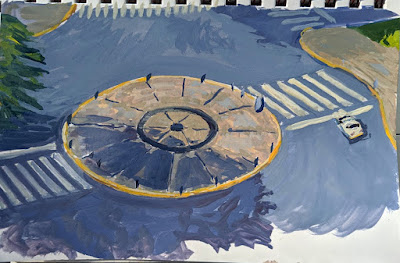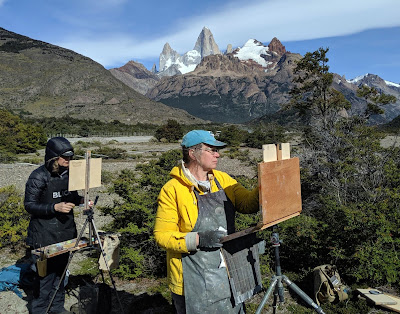“You don’t belong here,” the young men said. “Go home!”
 |
| Rio Electrico, by Carol L. Douglas, 8X10, available. |
Whatever our quarantine meant on Thursday, on Friday we were permitted to hike along the
Rio Electrico. The trailhead is a few scant kilometers from
Hosteria el Pilar. The trail leads into
Los Glaciares National Parkand ultimately to Chile. We wouldn’t be walking that far; the park is closed. However, we would have views of other distant glaciers and mountains.
We’re traveling with fairly light kits, but they are still full painting kits. They weigh between 15 to 30 pounds each. Mine is on the heavier side and I did not bring a backpack. My solution is to loop the strap of my messenger bag across my chest, like pictures of Navajo women in my long-obsolete schoolbooks. It works, more or less, although after 8.8 miles of moderate hiking, my neck was feeling the strain.
Keeping a low profile is paramount, so we traveled in two small groups. Mine included
Kellee Mayfield,
David Diaz, and
Lynn Mehta. We immediately proved our lack of woodscraft by neglecting to download a map. Instead, we searched the dust for footprints, as if we were trackers in a spaghetti western. A few kilometers of this nonsense and we found the trailhead. It was marked with large brown-and-yellow signs, directly across the road from a parking lot.
 |
| Jane Chapin above the Rio Electrico. |
Guillermo had warned us not to allow ourselves to perspire as we climbed. “This is not Amsterdam,” he said. The realization that we were hiking in the Andes came slowly, but it left us rather awestruck. If I had a bucket list, this should have been on it. Most of the hike was through a wooded glade that the ever-present wind could not penetrate. It was, indeed, warm. But when we cleared the trees, the piercing wind was frigid. Wet clothes would have been dangerous.
Our first destination was a
refugia two hours up the pass. A kilometer short of it, we came across another band of our fellows—
Jane Chapin,
Natalia Andreeva,
Lisa Flynn and Natalia’s husband, Alexander. They’d been driven back from the
refugia. It was occupied by four young Argentine bucks, intent on riding out the virus in the solitude of Patagonia. “You don’t belong here,” they said. “Go home!” It has been our only negative encounter so far.
Argentina has banned internal flights because too many people are using the break to vacation. I understand. Most of us live undemanding lives compared to our ancestors. We haven’t learned to take danger seriously. The impulse to break quarantine is terrific.
 |
| Painting along the Rio Electrico. Photo courtesy of Jane Chapin. |
But it didn’t matter whether these four twenty-somethings were survivalists or just want to party in peace. We were best off leaving them to it. We retreated along the riverbank and set up to paint a superb view of what may or may not be Glaciar Cagliero Sur. It was horrendously windy. I’ve painted in more pleasant blizzards, and I’m from Buffalo. “We’ve hiked two hours to paint for fifteen minutes,” laughed David Diaz.
Alas, we are again confined to the grounds. We will be allowed to roam when we have a certificate of quarantine, or when the Marines show up to rescue us. Alas, our second set of flights has been cancelled. Right now, we have enough flight credits to travel South America for a year, great whacking charges on our credit cards, and no way home.
Meanwhile, the US State Department is calling in all American citizens. That’s of very little use when there are no domestic or international flights available. Those of us with political connections have contacted them to see if the government can intervene.
 |
| Meanwhile, the clouds and the sky remain spectacular. |
Matthew Parris has a
wonderful little essay in this week’s
Spectator on the thrill of apocalypse to school children and other romantic souls. We all like breaks in routine—for a while. “On how many gravestones in how many churchyards does that phrase from Romans 15, 9-11, ‘and they shall sing a new song’, appear?” he asks.
However, the break grows old. We begin to long for a return to the familiar. Despite internet contact (which the hosteria laid on in the face of crisis), we want to see our family and friends again. To maintain sanity, we cling resolutely to our groove. We eat breakfast, we contact our families, we wash our unmentionables in the sink, and then we paint. And then we repeat.


















